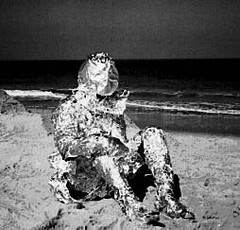Spiritual Eroticism: Part V
Sebastian
The Getty Museum required that I remove the image, "Saint Sebastian Attended by an Angel" from my blog. It was located in this position, alligned to the right side of the document.*
While composing this series of entries and choosing art works to illustrate them, three of four art works were of Saint Sebastian. In retrospect, I’m wondering, why. It could be that the subject says something about my specific brand of spirituality, eroticism, and sexuality, which of course, must be slightly different from everyone else's since no two people have the same genetic structure and / or the same formative and cumulative experience. It could also be that this religious subject, both as a narrative and as an image, is potentially charged with homosexual eroticism. It is also necessary to ask the following question in order to figure out my first quandary. Who was Saint Sebastian?
I must confess, I knew very little about Sebastian, the man, and after doing a search, I don’t know a great deal more. There is much written about the history of Sebastian as a religious and cultural icon, but very little biographical information survives. We do know that he was a nobleman and that he may have been from Milan. He was in the Imperial body guard and was in charge of a company of archers during the 4th century AC. He served under emperors Maximian and Diocletian in their personal (Praetorian) guard, and was executed by Diocletian’s archers because he rescued Christian Martyrs Marcellinus and Mark. He survived and was nursed back to health by a woman named Irene. When Diocletian discovered that Sebastian was alive and well, he had his soldiers beat Sebastian to death in a second public execution in the Hippodrome in Constantinople.
These details--based on accounts written centuries after Sebastian's death and therefore largely apocryphal--may have helped form Sebastian's subsequent reputation as a homosexual martyr since his story constitutes a kind of "coming out" tale followed by his survival of an execution that may be read symbolically as a penetration.*
Sebastian, the preventer of plague in the Catholic tradition, became an extremely popular subject of Renaissance artists, and he was always portrayed as a young man of extreme Hellenic beauty. The last based in part on the Renaissance interest in all things ancient Roman and Greek. At the same time, however, these mostly Italian artists - among them were Botticelli, Giorgione, il Sodoma, Antonello da Messina, Mantegna, and Tintoretto - purposefully used a homoerotic subject disguised by and hidden within the mechanism of church tutelage. During the nineteenth century Sebastian was portrayed by writers, composers, and artists of aesthetic visualization as an androgynous and ecstatic, tortured saint. In both the Modern and the Postmodern eras Saint Sebastian has been the subject of many writers, artists and film makers; among the most prominent F. Holland Day, Marsden Hartley, Derek Jarman, Frank O’Hara, Pierre and Gilles, and Marcel Proust.
I’m not done with this topic. There will be more in the near future.
* "Saint Sebastian Attended by an Angel, Getty Museum," Explore art pages Getty Museum site, “http://www.getty.edu/art/collections/objects/o874.html” (Saturday, August 8, 2004, 10:28 AM. EDT)
To read about van Dyke’s drawing go to The Getty Museum site
*2 Kaye, Richard, “Saint Sebastian,” Encyclopedia of Gay, Lesbian, Bisexual, Transgendered, and Queer Culture, “http://www.glbtq.com/literature/sebastian_st.html,” (New England Publishing Associates, 2000 with last update, March 1, 2004)(viewed Tuesday, August 10, 2004, 8:48 AM. EDT)
E-mail me! My e-mail address is ZacSfuts@aol.com.
Visit my homepage
AOL Hometown



0 Comments:
Post a Comment
<< Home